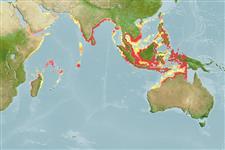>
Clupeiformes (Herrings) >
Dorosomatidae (Gizzard shads and sardinellas)
Etymology: Sardinella: Latin and Greek, sarda = sardine; name related to the island of Sardinia; diminutive (Ref. 45335).
More on author: Bleeker.
Environment: milieu / climate zone / depth range / distribution range
Écologie
marin; profondeur 0 - 50 m (Ref. 188). Tropical; 25°N - 23°S, 41°E - 137°E (Ref. 188)
Indo-West Pacific: Madagascar (but apparently not elsewhere in the western Indian Ocean), Madras, Indonesia, northern Australia. Chan's Hong Kong and Taipei specimens were most likely Sardinella hualiensis. Occurrence in Thailand (Ref. 1632) needs to be confirmed.
Taille / Poids / Âge
Maturity: Lm ? range ? - ? cm
Max length : 13.0 cm SL mâle / non sexé; (Ref. 188); common length : 12.0 cm SL mâle / non sexé; (Ref. 188)
Épines dorsales (Total) : 0; Rayons mous dorsaux (Total) : 13 - 21; Épines anales: 0; Rayons mous anaux: 12 - 23. Body deep; total scutes 29 to 32. Vertical striae on scales overlapping or sometimes continuous at center of scale, numerous small perforations on hind part of scale. Closely resembles S. hualiensis which has dark dorsal and caudal fin tips. Differs from other deep-bodied species chiefly in its lower gill raker count and presence of a dark spot at dorsal fin of origin.
Forms schools in coastal waters (Ref. 188, 75154).
Life cycle and mating behavior
Maturité | Reproduction | Frai | Œufs | Fécondité | Larves
Whitehead, P.J.P., 1985. FAO Species Catalogue. Vol. 7. Clupeoid fishes of the world (suborder Clupeoidei). An annotated and illustrated catalogue of the herrings, sardines, pilchards, sprats, shads, anchovies and wolf-herrings. FAO Fish. Synop. 125(7/1):1-303. Rome: FAO. (Ref. 188)
Statut dans la liste rouge de l'IUCN (Ref. 130435: Version 2024-1)
Menace pour l'homme
Harmless
Utilisations par l'homme
Pêcheries: intérêt commercial mineur
Outils
Articles particuliers
Télécharger en XML
Sources Internet
Estimates based on models
Preferred temperature (Ref.
123201): 27.6 - 29.2, mean 28.6 °C (based on 786 cells).
Phylogenetic diversity index (Ref.
82804): PD
50 = 0.5000 [Uniqueness, from 0.5 = low to 2.0 = high].
Bayesian length-weight: a=0.00813 (0.00495 - 0.01335), b=3.09 (2.95 - 3.23), in cm total length, based on LWR estimates for this species & Genus-body shape (Ref.
93245).
Niveau trophique (Ref.
69278): 2.9 ±0.3 se; based on size and trophs of closest relatives
Résilience (Ref.
120179): Haut, temps minimum de doublement de population inférieur à 15 mois (Preliminary K or Fecundity.).
Fishing Vulnerability (Ref.
59153): Low vulnerability (10 of 100).
Nutrients (Ref.
124155): Calcium = 338 [184, 527] mg/100g; Iron = 2.11 [1.25, 3.75] mg/100g; Protein = 20.4 [19.5, 21.4] %; Omega3 = 0.312 [0.152, 0.614] g/100g; Selenium = 82.9 [43.0, 161.6] μg/100g; VitaminA = 36.7 [11.6, 111.0] μg/100g; Zinc = 1.4 [1.0, 1.9] mg/100g (wet weight);
